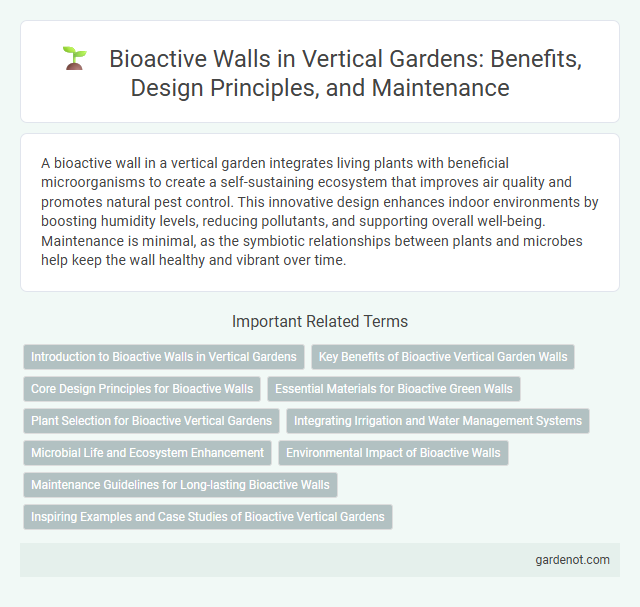A bioactive wall in a vertical garden integrates living plants with beneficial microorganisms to create a self-sustaining ecosystem that improves air quality and promotes natural pest control. This innovative design enhances indoor environments by boosting humidity levels, reducing pollutants, and supporting overall well-being. Maintenance is minimal, as the symbiotic relationships between plants and microbes help keep the wall healthy and vibrant over time.
Introduction to Bioactive Walls in Vertical Gardens
Bioactive walls in vertical gardens integrate living plants with natural microorganisms, creating a self-sustaining ecosystem that enhances air quality and promotes biodiversity. These walls use substrates and hydroponic systems designed to support microbial activity, which helps break down pollutants and improve plant health. Incorporating mycorrhizal fungi and beneficial bacteria boosts nutrient cycling, making bioactive walls an innovative solution for urban greening and environmental wellness.
Key Benefits of Bioactive Vertical Garden Walls
Bioactive vertical garden walls enhance indoor air quality by leveraging natural plant processes to filter pollutants and increase oxygen levels. They contribute to improved mental well-being through exposure to greenery, reducing stress and boosting productivity in residential and commercial spaces. These walls also promote biodiversity by supporting beneficial microorganisms, creating a healthier and more balanced indoor ecosystem.
Core Design Principles for Bioactive Walls
Core design principles for bioactive walls emphasize selecting diverse plant species that promote air purification and humidity regulation while enhancing aesthetic appeal. Incorporating natural elements such as microorganisms and fungi supports a balanced ecosystem that fosters plant health and longevity. Optimal structural support and irrigation systems ensure proper water distribution and root stability, vital for sustainable vertical garden growth.
Essential Materials for Bioactive Green Walls
Essential materials for bioactive green walls include high-quality substrate blends that support microbial life and root health, such as organic compost mixed with porous mediums like coconut coir or perlite for optimal drainage and aeration. Specialized irrigation systems ensure consistent moisture levels while preventing waterlogging, crucial for maintaining a thriving bioactive ecosystem. Incorporating beneficial microorganisms and mycorrhizal fungi enhances nutrient cycling and plant vitality within the vertical garden structure.
Plant Selection for Bioactive Vertical Gardens
Plant selection for bioactive vertical gardens involves choosing species that thrive in vertical environments while supporting a healthy ecosystem. Ferns like Nephrolepis exaltata and tropical plants such as Philodendron provide high humidity and organic matter, promoting beneficial microfauna. Incorporating epiphytes and moisture-loving species enhances biodiversity and contributes to air purification in bioactive walls.
Integrating Irrigation and Water Management Systems
Bioactive walls in vertical gardens incorporate advanced irrigation and water management systems that optimize water usage through precision drip irrigation and automated timers. These systems enhance plant health by maintaining consistent moisture levels and reducing water waste, promoting sustainability. Integrating sensors for soil moisture and nutrient monitoring ensures efficient resource allocation and supports the bioactive ecosystem's balance.
Microbial Life and Ecosystem Enhancement
Bioactive walls in vertical gardens foster diverse microbial life that enhances soil health and nutrient cycling, promoting robust plant growth. These living walls support a balanced ecosystem by encouraging beneficial microorganisms that suppress pathogens and increase plant resilience. Integrating bioactive features into vertical gardens optimizes air purification and moisture retention, contributing to sustainable urban biodiversity.
Environmental Impact of Bioactive Walls
Bioactive walls significantly improve urban air quality by filtering pollutants and producing oxygen through plants and beneficial microorganisms. These vertical gardens enhance biodiversity by providing habitats for insects and birds, contributing to urban ecosystem health. Their natural insulation properties also reduce building energy consumption, lowering carbon footprints in cities.
Maintenance Guidelines for Long-lasting Bioactive Walls
Regular watering schedules and proper light exposure are essential to sustain the health of plants in a bioactive wall. Incorporating nutrient-rich soil and beneficial microorganisms supports continuous growth and pest resistance. Routine pruning and monitoring for mold or pests prolong the lifespan and aesthetic appeal of the vertical garden.
Inspiring Examples and Case Studies of Bioactive Vertical Gardens
Bioactive vertical gardens integrate living plants with microbial communities to create self-sustaining ecosystems that improve indoor air quality and enhance well-being. Notable case studies, such as the Babylonstoren farm in South Africa and the Amazon Spheres in Seattle, showcase innovative designs combining biodiversity with architectural elements for both aesthetic and environmental benefits. These examples demonstrate the potential of bioactive walls to transform urban spaces by fostering natural habitat restoration and promoting sustainable building practices.
Bioactive wall Infographic

 gardenot.com
gardenot.com